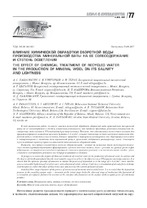Влияние химической обработки оборотной воды производства минеральной ваты на ее солесодержание и степень осветления

Authors
Date
2017Publisher
Another Title
The effect of chemical treatment of recycled water in the production of mineral wool on its salinity and lightness
Bibliographic entry
Влияние химической обработки оборотной воды производства минеральной ваты на ее солесодержание и степень осветления = The effect of chemical treatment of recycled water in the production of mineral wool on its salinity and lightness / А. С. Панасюгин [и др.] // Литье и металлургия. - 2017. – № 4 (89). - С. 77-83.
Abstract
В ходе выполнения работ по оценке влияния химической обработки оборотной воды производства минеральной ваты на ее солесодержание и степень осветления установлено, что наиболее пригодным реагентом для решения поставленных задач является 25%-ный водный раствор аммиака. Показано, что оптимальным количеством аммиака для проведения процесса осаждения является диапазон 4–6 мл/дм3, меньшее количество не дает заметного осветления оборотной воды и снижения сухого остатка, большее приводит к повторному растворению уже образовавшегося осадка и соответственно к снижению доли осветленной воды и увеличению содержания растворенных солей. Установлен трехстадийный характер процесса взаимодействия аммиака и оборотной воды. Выявлено, что процесс осаждения в системе оборотная вода – аммиак на начальном этапе лимитирует химическая стадия зародышеобразования (формирование кристаллического осадка), далее - реакции на границе раздела фаз (образование на поверхности исходного зародышей сплошного продукта реакции), а на заключительной стадии – рост сплошного слоя продукта реакции и еще непрореагировавшего аммиака.
Abstract in another language
In progress to assess the impact of chemical treatment of recycled water in the production of mineral wool, its salinity and the degree of clarification found that the most suitable reagent to achieve the objectives is a 25% aqueous ammonia solution. It is shown that the optimum quantity of ammonia to initiate the process of deposition is in the range of 4–6 ml/dm3, lower number gives a noticeable lightening of recycled water and reduction of solids, a larger leads to a re-dissolution of already formed sludge and therefore to reduce the share of bleached water and increase the content of dissolved salts. Installed three stage character of the process of interaction of ammonia and recycled water. It is revealed that the deposition process in the recycling system water – ammonia at the initial stage limits the chemical stage of nucleation (the formation of a crystalline precipitate), followed by reaction at the interface (the formation on the surface of the original germs of continuous product.
View/
Collections
- №4 (89)[25]
